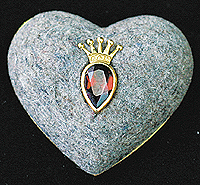Acting as a metaphor for many human emotions while literally pumping life through our bodies, the heart plays a powerful role in many cultures. It's use as a symbol of love and empathy is a centuries old tradition, accepted by many and universally known.
Even language developed to encompass the heart's sensibility. We have affairs of the heart, we talk heart-to-heart, find some things heart wrenching, can be heart broken and feel things in a heartfelt way. Happy people are considered hearty. People can lose heart. Downtown tends to be in the heart of the city.
But is the heart the place where love really originates and is felt?
According to Belgium cardiologist Dr. N. Boyadjan, the author of "The Heart: its History, its Symbolism, its Iconography and its Diseases," the heart is the "first to receive cerebral influxes through the nervous, sympathetic and para-sympathetic systems." Attributing the findings to the father of experimental physiology, Dr. Claude Bernard, Boyadin writes, "the brain receives the effects of circulation of the blood, whence comes the permanent interaction between...the heart and the brain."
This is the root cause of the "long metaphysical argument, which has existed in all the different civilizations, concerning the seat of the soul. For some, the seat is the heart, for others, the brain."
Mostly, artists have decided on the heart, and for centuries have depicted it in a myriad of ways from bejeweled brooches and religious ex-votos to earthen inkwells and perfume bottles to precious metal winged hearts and ornate medallions.
Only cultures like the Aztecs and the Egyptians, where hearts were removed from dead bodies, knew of its shape and drew it that way. There are no hearts in ancient Chinese, Hindu or Mesopotamian art works. Over time the shape, which, when depicted always had the aorta arch intact, morphed into what we now see on cards and in pop art.
The true shape of a heart is more like a fat, red fist. But for purposes of romance and love nothing beats the graphically clean and iconic shape that evolved, with its rounded shoulders and the pointed bottom. It spoke volumes. The aorta stem disappeared. In Valentine's Day cards, which began being circulated in the 1800s, hearts were vivid red or flowery replicas. In the 1980s, artist Jim Dine turned hearts into something hip and colorful to hang on the walls, not just send to Mother.
But the heart is morphing again. Artists have rediscovered the shape, the aorta stem is back and the heart is mystical once more. Depictions look more like a place where the reality of love could reside. Love can be erratic and dicey. The beloved may be ill, might die, or be killed, cheat on us or betray us. This can leave love's home fairly scarred, but in the creative mind of an artist still awe inspiring.


 A brooch for sale at Jensen Stern in Ketchum. Photo by David N. Seelig
A brooch for sale at Jensen Stern in Ketchum. Photo by David N. Seelig



































